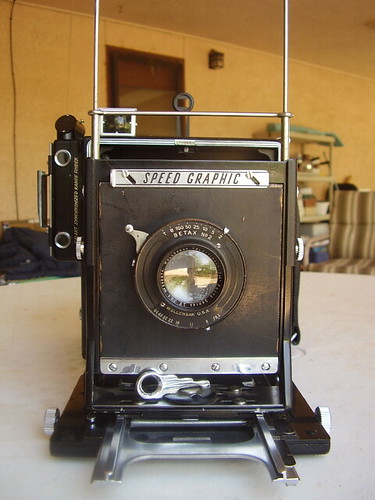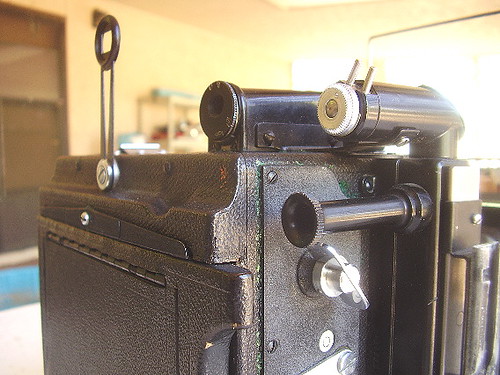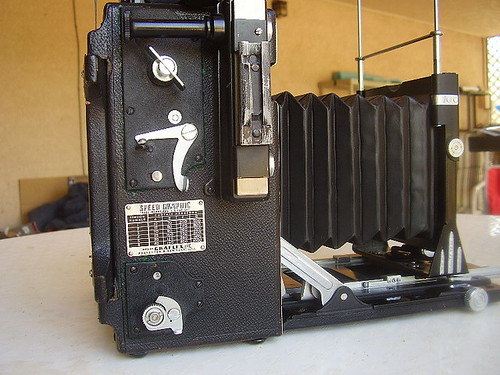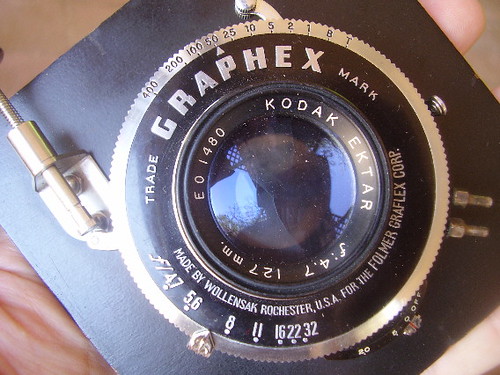Old High Tech Camera
I just got a “new” camera. It is an engineer’s dream, albeit circa 1946. But if you are a good, patriotic, historically minded engineer it is still a marvel. It is the Speed Graphic made famous by news photographers of the mid 20th century, who were using them to make other people famous. The picture of the flag raising on Iwo Jima was taken by a Speed Graphic.

Some would call it complicated, perhaps overly so. It’s not. Not for someone who was trained to operate complicated equipment (some from the same era) in the Navy anyway.
This purchase is just the beginning of a new hobby journey I’m on. But like most new hobbies, the learning and finding stage is very exciting. After getting skunked and sniped on “that auction site” for many weeks, I finally got this one. I took a chance, the photos were blurry and too dark to see condition. The seller mentioned two lenses, but didn’t describe the second. No matter what it was, the other lens he mentioned is a fine one, a top of the line Kodak Ektar that was the most popular lens for professionals.
Graflex made Speed Graphic cameras for decades and in many models. Now that I’ve received it I’m thrilled with what it turns out to be. It’s a 1946 black and chrome Anniversary model with all the matching accessories. It has the big side-mounted flash with two reflectors (these were used to make the Light Sabers in Star Wars, so you know they’re retro-cool), the original cord to power up a “special” sight, film backs, and even an original carrying case for all.
Does it work? Many people are afraid to buy old stuff. I never have been. If you buy quality and it’s in good condition, many items made in the 1910s-1950s are BETTER than those today. Back in the day I bought many 100 year old target firearms that would outshoot modern ones.

Check out the art deco details on the brackets that hold the bellows and the locking ring under the lens. This thing is classy! But back to engineering. It all folds out of it’s box with satisfying loud clicks. The focus rolls on perfect rack and pinion rails. This thing is build like an old colt revolver (can you see why I like it).

Focusing and sighting can be done with no less than 5 methods. There are viewfinders and range finders and “quick sights” galore. The image is projected on the back (like a modern digital camera’s screen – but analog) for fine focusing on a ground glass that is revealed when you press a hidden button.
But the coolest technology is the focus-spot option. At the top of the side-mounted Kalart range finder is a small tube with two prongs. You power up the prongs with the D-cell flash handle. The cord was very fragile from 60 years, so I substituted one from my electric shaver. Then to my amazement when I click a tiny button, two light beams shine from the range finder windows. You point the dots on the object being photographed, and adjust the focus until the two dots come together. This was used by the photojournalist in low light settings like clubs or on the street at night. So to answer the question, yes, everything works. The shutters wiz like little timebombs, the serial numbers all match up, and I discovered the mystery lens is a pretty good one for portraits and still life photography.

Speaking of shutters, that’s why this model is called a “Speed” Graphic, compared to their other cameras. This one has two shutters, one on the lens, and another in the back. The back shutter runs a curtain with slots past the film. Because of it’s design it can run at 1/1000 (.001) of a second, pretty fast in the day. To do this appears complicated, but again, I love it. Referring to the handy table mounted on a plate on the right side, you determine the letter/number referenced by the shutter speed desired. Then you wind the lower key, while watching the tension numbers in a window. Next you wind an UPPER key until your letter scrolls into another window. When all is ready, you pull the lever and the shutter fires. That works fine too.
I’m impressed with what American ingenuity could do. I’m also impressed that you can get one of these for less than the cheapest digital camera at walmart. And in a few days when my film arrives, pictures will be carefully crafted, instead of the usual “point and click.”



Some would call it complicated, perhaps overly so. It’s not. Not for someone who was trained to operate complicated equipment (some from the same era) in the Navy anyway.
This purchase is just the beginning of a new hobby journey I’m on. But like most new hobbies, the learning and finding stage is very exciting. After getting skunked and sniped on “that auction site” for many weeks, I finally got this one. I took a chance, the photos were blurry and too dark to see condition. The seller mentioned two lenses, but didn’t describe the second. No matter what it was, the other lens he mentioned is a fine one, a top of the line Kodak Ektar that was the most popular lens for professionals.
Graflex made Speed Graphic cameras for decades and in many models. Now that I’ve received it I’m thrilled with what it turns out to be. It’s a 1946 black and chrome Anniversary model with all the matching accessories. It has the big side-mounted flash with two reflectors (these were used to make the Light Sabers in Star Wars, so you know they’re retro-cool), the original cord to power up a “special” sight, film backs, and even an original carrying case for all.
Does it work? Many people are afraid to buy old stuff. I never have been. If you buy quality and it’s in good condition, many items made in the 1910s-1950s are BETTER than those today. Back in the day I bought many 100 year old target firearms that would outshoot modern ones.

Check out the art deco details on the brackets that hold the bellows and the locking ring under the lens. This thing is classy! But back to engineering. It all folds out of it’s box with satisfying loud clicks. The focus rolls on perfect rack and pinion rails. This thing is build like an old colt revolver (can you see why I like it).

Focusing and sighting can be done with no less than 5 methods. There are viewfinders and range finders and “quick sights” galore. The image is projected on the back (like a modern digital camera’s screen – but analog) for fine focusing on a ground glass that is revealed when you press a hidden button.
But the coolest technology is the focus-spot option. At the top of the side-mounted Kalart range finder is a small tube with two prongs. You power up the prongs with the D-cell flash handle. The cord was very fragile from 60 years, so I substituted one from my electric shaver. Then to my amazement when I click a tiny button, two light beams shine from the range finder windows. You point the dots on the object being photographed, and adjust the focus until the two dots come together. This was used by the photojournalist in low light settings like clubs or on the street at night. So to answer the question, yes, everything works. The shutters wiz like little timebombs, the serial numbers all match up, and I discovered the mystery lens is a pretty good one for portraits and still life photography.

Speaking of shutters, that’s why this model is called a “Speed” Graphic, compared to their other cameras. This one has two shutters, one on the lens, and another in the back. The back shutter runs a curtain with slots past the film. Because of it’s design it can run at 1/1000 (.001) of a second, pretty fast in the day. To do this appears complicated, but again, I love it. Referring to the handy table mounted on a plate on the right side, you determine the letter/number referenced by the shutter speed desired. Then you wind the lower key, while watching the tension numbers in a window. Next you wind an UPPER key until your letter scrolls into another window. When all is ready, you pull the lever and the shutter fires. That works fine too.
I’m impressed with what American ingenuity could do. I’m also impressed that you can get one of these for less than the cheapest digital camera at walmart. And in a few days when my film arrives, pictures will be carefully crafted, instead of the usual “point and click.”



<< Home